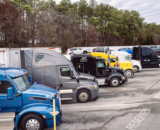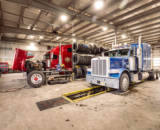The economy is accelerating, consumer spending is strong, freight volumes are increasing and the country is undergoing the third longest economic expansion in history, all of which is boding well for the trucking industry.
Those remarks came from Bob Costello, chief economist for American Trucking Associations, who sat down with a panel of truckstop and travel plaza operators at NATSO Connect in Nashville, Tenn., to discuss freight, key economic indicators and his expectations for the years ahead.
“I think we are in the midst of the greatest period in trucking post deregulation in 1980,” Costello said.
Costello expects the economy to grow 2.7 to 2.8 percent in 2018 and said that could continue into 2019. Loads were up 2.8 percent in 2017 but total miles driven remained flat. “That said, being flat was the best year since 2014. In 2015 and 2016, miles fell,” Costello said.
The average length of haul has decreased to 527 miles in 2017. In 2000, it just under 800 miles. “That is a 34 percent decrease in average length of haul,” Costello said.
Despite the decreased length of haul, the trucking industry will need more trucks to deliver loads, and those drivers will need to stop at truckstops and travel plazas, he said. “When we look out a decade or so, trucking will be the third fastest mode of growth and is going to be asked to haul 33 percent more tonnage. You can’t just increase the number of miles, you have to put more trucks on the road,” Costello said.
Given the strong economy, freight levels should continue to increase. There is a low unemployment rate and more than two million jobs have been created. “When the job market is tight, wages are going up. When wages are going up people generally spend the money,” he said adding that spending on goods, excluding services, is going to grow about 4.3 percent this year.
New housing construction and factory output is also on the rise and the inventory cycle through the supply chain is no longer a drag on freight volumes.
Freight volumes accelerate. “In the final quarter last year, freight volumes were up 7 percent. We know anecdotally that has spilled into this year,” Costello said.
During the session, Costello said he remains concerned over the future of the North American Free Trade Agreement, telling attendees NAFTA is critical to the trucking industry. An ATA study found that cross border activity supports 46,000 U.S. trucking jobs, including nearly 31,000 U.S. truck drivers. “Jobs completely depend on NAFTA trade. It generates $6.5 billion a year in revenue for the trucking industry,” he said.
Another challenge facing the trucking industry is the driver shortage, which has ballooned to 51,000. “If nothing changes that could grow to 175,000 in years,” Costello said. However, he doesn’t believe that is the case as fleets will increase wages to attract more drivers.
Costello said total loads were up 2.8 percent in 2017 but total miles driven remained flat. “That said, being flat was the best year since 2014. In 2015 and 2016, miles fell. The average length of haul has decreased to 527 miles in 2017. In 2000, it just under 800 miles. “That is a 34 percent decrease in average length of haul,” Costello said.
Despite the decreased length of haul, the trucking industry will need more trucks to deliver loads, and those drivers will need to stop at truckstops and travel plazas, he said. “When we look out a decade or so, trucking will be the third fastest mode of growth and is going to be asked to haul 33 percent more tonnage. You can’t just increase the number of miles, you have to put more trucks on the road,” Costello said.
Although electric truck technology is increasing, Costello said he expects diesel to remain the predominant fuel, particularly for long-haul trucking.
Costello's sesison was sponsored by Chevron.
Photo credit: Brittany Palmer/NATSO
Subscribe to Updates
NATSO provides a breadth of information created to strengthen travel plazas’ ability to meet the needs of the travelling public in an age of disruption. This includes knowledge filled blog posts, articles and publications. If you would like to receive a digest of blog post and articles directly in your inbox, please provide your name, email and the frequency of the updates you want to receive the email digest.

